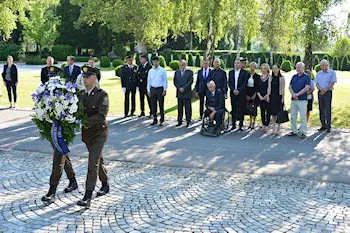Officially called Victory and National (Homeland) Thanksgiving Day and Day of Croatian Defenders this national holiday on 5 August celebrates the day in 1995 that Croats retook territory in the "Krajina" region from the hands of Serb rebels. Code named 'Operation Storm', the attack mobilized some 200,000 soldiers plus reservists and police on 4 August who attacked the Krajina in some 30 different places aiming to capture the region's capital at Knin. By 10am on 5 August, Croat soldiers had entered Knin and raised the Croatian flag over Knin castle. The fall of the castle marked the end of the so-called "Republic of Serbian Krajina" and sent around 200,000 Serbs, many of whose ancestors had settled the region centuries ago, fleeing into Serbia.
The event is commemorated by solemn wreath-laying ceremonies around Croatia but the main focus of attention is on the town of Knin where there are military parades and choirs, speeches, wreath-laying and a concert. In addition to politicians and dignitaries, the crowd often includes veterans and Croatian nationalists who have used the holiday as a forum to express ethnic hatred. As the actions of the Croatian army in seizing the territory have been the subject of prosecutions (and ultimate acquittal) of the generals involved, it is fair to say that Homeland Thanksgiving Day is Croatia's most controversial holiday.
Historical Background
The Krajina region was set up in the late 16th century as a series of military garrisons designed to protect the Austro-Hungarian empire from the encroaching Ottomans. The Austrians then invited Vlachs who were Orthodox Christians, possibly from Serbia, to settle the region. To encourage settlement, the newcomers were awarded land, special privileges and a special status within the state as long as they made a commitment to military service. As the centuries passed, the frontiersmen self-identified as Serbs and their presence became a sore point.
When Croatia declared independence from ex-Yugoslavia on 25 June 1991 its failure to guarantee minority rights in the new state prompted the Serbian enclave of Krajina to declare its independence from Croatia. As the claimed territory amounted to 18% of modern-day Croatia, it was a declaration that couldn't be and was not accepted by Zagreb. Heavy fighting erupted, broken by a series of UN-brokered cease-fires.
In January 1993 the Croatian army launched an offensive in southern Krajina which pushed the Krajina Serbs back and recaptured certain strategic points such as Zadar airport. In June 1993 the enflamed Serb population voted to join the Bosnian Serbs in an effort to create a Greater Serbia. "Ethnic cleansing" prompted the Croat population within the territory to flee en masse even as various peace plans and cease-fires were agreed to and broken.
Despite an arms embargo, the Croatian army began procuring arms and training from the United States, preparing their assault on the region. As the Krajina Serbs were badly outnumbered, the military operation against the Krajina was over in a matter of days. Yet the looting and burning inflicted upon Serb villages continued for months.
Since Operation Storm, most Croatian inhabitants have returned to the Krajina region. Some Serbs have returned but the Serbian population is nowhere near its pre-war level largely due to government obstructionism but also because of a lack of economic opportunity in the region. The two communities live in a kind of wary peace with very differing views of how or even whether to commemorate 5 August.
Related Pages
|

Join the Croatia Traveller Group
Recommended Experiences
©CroatiaTraveller 2005-2024 All rights reserved
